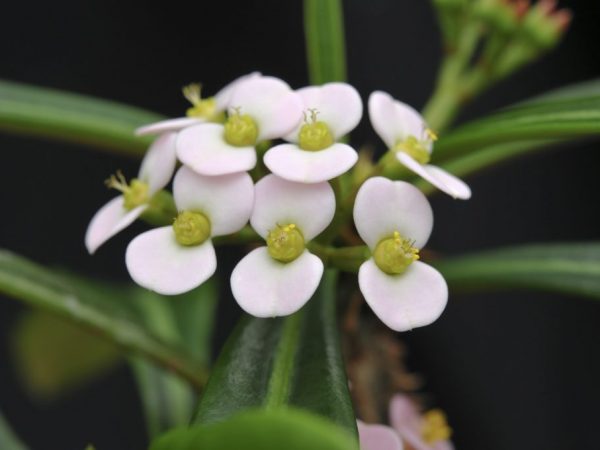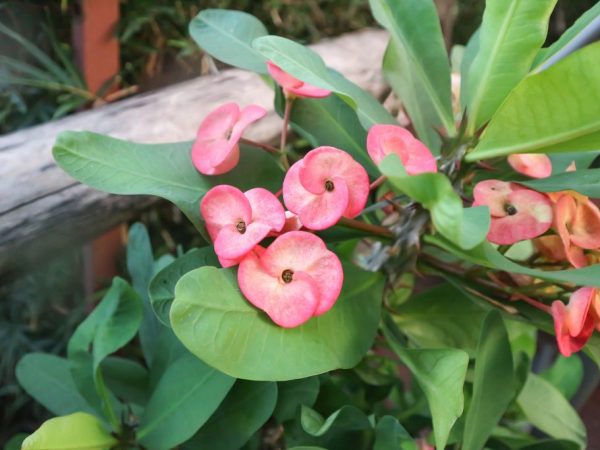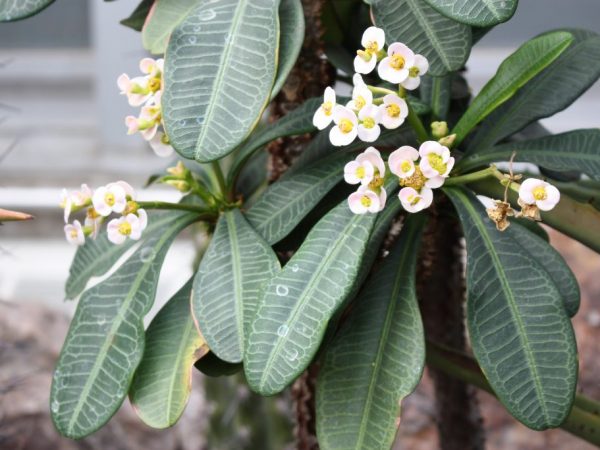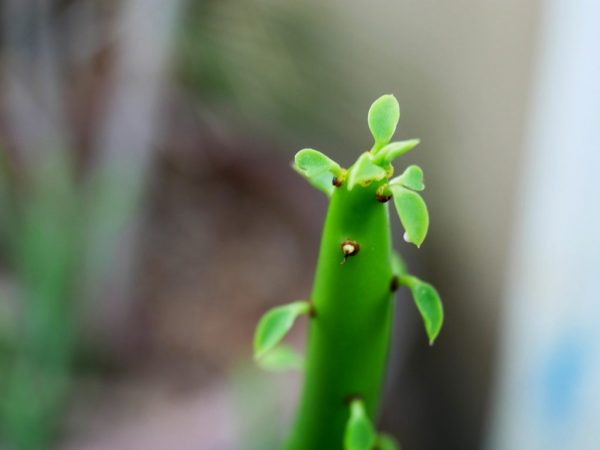Euphorbia Crested (Ribbed) - how to grow at home
Tropical Euphorbia has won the hearts of many flower growers. This evergreen plant with an unusual ribbed trunk is a real decoration for any interior. Consider what a flower looks like and how to properly care for it at home.

Euphorbia Crested (Ribbed) - how to grow at home
Description
The botanical name for the flower of the Euphorbia family is euphorbia lophogona. The second name is comb-ribbed. Homeland - about. Madagascar.
In its natural environment, it is found in forest areas where tropical and subtropical climates prevail.
Description of decorative deciduous perennial:
- the height in an adult specimen reaches 1.2 m;
- stem green, erect, sometimes spiral, has a pentahedral surface (brown at the base, without edges);
- at the very top, the central conductor of a rich green color with large spines;
- the edges are covered with small red villi;
- lateral processes repeat the structure of the main trunk;
- leaves are glossy, leathery, green with a reddish tint, size 12x3-5 cm, after falling off they leave visible scars on the surface of the stems;
- leaves are formed at the top of the shoots, which gives the plant a palm-shaped crown;
- the leaf plate contains a pronounced silvery vein in the center and transverse stripes of the same tone.
Hybrid form
This variety has one subspecies - milk euphorbia (euphorbia lactea cristata). A large plant reaches 2 m in height, has good drought resistance.
The stem is pentahedral with several lateral shoots of the same shape. The central shoot of an emerald tone, in the center contains a thick light green stripe. Dark brown spines form on the edges.
Signs
According to popular beliefs, such a flower must be kept in the house, because it has a pacifying effect on all family members and household members, relieves tension and leads to harmony in family relationships.
A positive effect is possible if all the rules of care are followed. If the plant suffers from lack of attention, the magical effect changes to a negative one.
Purchase and adaptation
You can buy ribbed spurge in one of the flower shops.
When buying, you need to conduct a thorough inspection to make sure the health of the flower:
- stem without cracks, red or brown growths, rotting;
- leaves of a uniform tone, not flabby, without yellowness;
- the substrate is slightly moistened, without mold and acidification.
After purchase, the plant is quarantined for 3 weeks - kept separate from other flowers. During that time, it turns out to determine whether there are parasites or any infections on it. If necessary, they are treated with fungicides or insecticides.
Landing
For planting, they take a small-sized container, because in a large stem it begins to rapidly stretch, and in a small one - ribbed spurge intensively grows foliage.
A plastic or ceramic pot with holes in the bottom will do. The first layer is drainage from pebbles or expanded clay, the second (up to half the volume) is a fertile composition.
The roots are lowered, gently straightened, then a nutritious soil mixture is poured to the top, watered abundantly.
Growing conditions
Site and soil selection

Protect the flower from direct sunlight
Given the natural growth conditions, the flower needs a well-lit place, without direct sunlight. The optimal duration of a light day is 4-5 hours.
The pot is placed on a window on the west or southwest side of the house.
If this is not possible, it is placed on the southern windowsill, providing partial shade at lunchtime. Otherwise, the stems and leaves will receive severe burns and lose their original decorative effect.
When kept in the northern part, the spurge will slowly grow, and the aboveground part will turn pale.
In winter, if the flower does not have enough light, you can use artificial lighting lamps. The device is installed at a distance of 50 cm from the crown to avoid overheating and burning of stems and leaves.
A slightly acidic and loose soil mixture for cacti and succulents is suitable for growing milkweed. You can buy it in a store or prepare it yourself by mixing sand with leafy soil and peat in equal amounts.
The second option: mix sand, humus, leaf and peat soil in a ratio of 2: 2: 1: 1.
Temperature
At different times of the year, he is provided with a certain temperature:
- in the phase of active growth and development (in spring and summer), they are kept at a regime of 20 to 25 ° C;
- in autumn and winter - they lower the indicators to 16-17 ° С, which will help preserve the decorative effect and health of the plant.
In warm seasons, it can be placed on a balcony, loggia or terrace, where there is fresh air, no drafts and direct sunlight.
Humidity
The optimum moisture content is 60-65%. To provide them in the spring and summer, frequent spraying of the aboveground part with warm water from a spray bottle is carried out.
In extreme heat, double irrigation is required. Additionally, a container with water is placed next to the pot, the flower is placed on a pallet with wet pebbles or expanded clay.
In the winter season, it is not necessary to spray - purely for hygienic purposes, this is done no more than twice a month.
Care requirements
A tropical succulent plant grows successfully at home if it is provided with proper and timely care.
Watering
For humidification, use filtered or settled water at room temperature. Watering is needed regular, but moderate - only as the soil dries up to a depth of 5-6 cm. Usually, during the growing season, it is watered twice a week.
In autumn and spring, when euphorbia enters the resting stage, the frequency is reduced to once a month.
After each moistening, light and superficial loosening of the substrate is required to maintain its moisture and air permeability.
Top dressing
With the arrival of spring in the active growing season, young foliage is formed on the tops of the shoots. At this moment, the flower begins to feed. Use purchased solutions for cacti and succulents, or mineral dressings (prepared according to the instructions).

Top dressing increases plant immunity
The frequency of application is once every 7 days during the warm season. Towards the end of August, food is completely stopped.
With such fertilization, euphorbia grows quickly and maintains strong immunity against diseases and pests.
Pruning
For this variety, crown shaping is not needed, but regular sanitary haircut is required every spring before the beginning of the growing season.To avoid infection with infections, pests and to preserve the decorative effect of the crown, cut out all shoots, leaves that are dry, rotted or yellowed.
For this manipulation, a sterile sharp instrument is used, and after it is carried out, the cut sites are powdered with charcoal.
Bloom
To stimulate flowering in this plant, you do not need to create special conditions. If it receives enough light, moisture and nutrients, it will release the first inflorescences already in the second year of cultivation.
At the top of the shoots, beautiful, small flowers of pink or white tones are formed on reddish or yellow-green peduncles.
Transfer
This procedure is mandatory for purchased plants, since the substrate in which they were sold is not suitable for growing. In the future, the transplant is carried out every three years.
Technology:
- the flower is watered abundantly;
- an hour later, they are removed and transferred together with an earthen lump into a container 2-3 cm larger in diameter than the previous one;
- fill up the fertile soil, tamp it slightly.
An urgent need to transplant a plant whose root system is rotting or damaged by harmful insects. They use the following scheme:
- flowers are watered abundantly, removed and lowered into a container of water to wash off the remnants of the earth;
- the roots are carefully examined, all damaged parts are cut out to healthy tissue, powdered with charcoal, dried and transplanted into a new pot with sterile and fertile soil mixture, moistened.
Reproduction methods
Ribbed spurge can be propagated in several ways, the technology for obtaining new specimens is different for each method.
Seeds
The appearance of seeds occurs in the second year of life, after the plant has faded. Euphorbia often scatters them, so new seedlings appear by self-seeding. This speaks from the good germination of seeds.
The collected seed is laid out on the surface of a moistened substrate, which is used for planting adult plants. To obtain seedlings, use seedling boxes, bowls or plastic containers.
Seedlings are sprinkled on top with a thin layer of soil mixture, irrigated with a spray bottle, covered with a transparent film or glass, and placed in a warm place with diffused lighting.
Further care consists in periodic ventilation, irrigation with warm water. The shelter is removed after the mass germination of seedlings. The pick is carried out at the stage of the appearance of one pair of leaves. Use small flowerpots with holes at the bottom, the mixture is taken the same as for planting adult flowers.
With good and regular care for the year, seedlings can reach 15 cm in height.
Cuttings
Rooting of cuttings is carried out in the spring, when the plant has not yet started to grow. The apical shoot is cut off with a length of 10-12 cm, deepened into a wet substrate by 3-4 cm, then watered, covered with a half of a plastic bottle.

Seedlings need to be well looked after
Until the moment the seedling takes root and begins to form new foliage, it is periodically ventilated and moistened. After about 2-3 months, when the stalk grows roots, it can be transplanted into a pot for a permanent habitat.
Diseases and pests
Regardless of the season, this variety of milkweed can be damaged by various parasites and infections, especially if the rules of care are violated. Having familiarized yourself with their names, symptoms and methods of treatment, you can preserve its health and decorativeness.
| Diseases and pests | Signs | Treatment methods | Prophylaxis |
| Root, stem or gray rot | It develops in plants suffering from frequent waterlogging. The lesion begins at the roots, then spreads to the lower part of the stems. The trunk becomes covered with a gray or black coating, becomes slippery, which leads to the death of the flower | It is impossible to cure a diseased specimen, therefore it is better to cut and root the apical cutting. The mother plant is disposed of | Adjust the irrigation system, avoid waterlogging with cold water |
| Alternaria | Fungal disease manifests itself in the form of dark brown or black dense spots on the surface of stems and leaves. | In the fight against this disease, antibacterial drugs are used - Acrobat MT, Ridomil Gold or Skor. All diseased parts are cut out before processing. | Use a sterile substrate for planting, transplanting. Buying healthy plants |
| Bacteriosis | Over-watering, high humidity and the use of infected seeds when planting are the main causes of the development of the sore. Stems and leaves rot and get wet. Euphorbia grows poorly, damaged parts secrete a liquid with an unpleasant putrid odor | If the roots are damaged, it makes sense to revive the flower. It is removed from the pot, all the soil is washed off, all diseased parts are cut out to healthy tissue, then the root system is dipped in one of the fungicides for 2 hours. Dried, transplanted into a new pot with a sterile substrate. If the stems and leaves are rotten, euphorbia should be disposed of | Take disinfected soil for planting and transplanting, regularly inspect the lower part of the stem for bacteria damage |
| Mosaic | Leaves and stems are covered with a kind of patterned pattern | There are no drugs that can help get rid of this disease. At the initial stage, you can remove damaged areas, treat with Ridomil Gold or Quadris. At an advanced stage, the flower is thrown away | Optimize care, plant in sterile soil |
| Aphid | A massive invasion of this parasite can lead to rapid death. The insect feeds on the juice of all organs. Leaves curl, turn yellow, stems wither. | Treat the crown twice with an interval of 7 days with Karbofos or Fundazol | For prevention, it is necessary to periodically wash the shoots and leaves with a solution of household soap (once a month) |
| Shield | These parasites in the form of brown or red plaques stick to the surface of stems and leaves, sucking the juices out of them. Damaged spots turn black, then die off | For the fight, Actellik or Phosbecid is used. The crown and soil are irrigated twice with an interval of 7 days. Before processing the parasites, remove with a cotton sponge dipped in one of the fungicides | Purchase of healthy plants, regular check-ups for damage |
| Root mealybug | It feeds on the juice of young roots, which leads to wilting and yellowing of the aerial part | At an early stage, the flower is removed from the container, all the soil is washed off, then dipped into a solution of one of the insecticides, dried, transplanted into a new container with sterile soil mixture. Additionally irrigate the crown with Aktellik or Aktara | Use a disinfected planting and transplanting substrate. Disinfect seeds before sowing in a strong solution of potassium permanganate |

